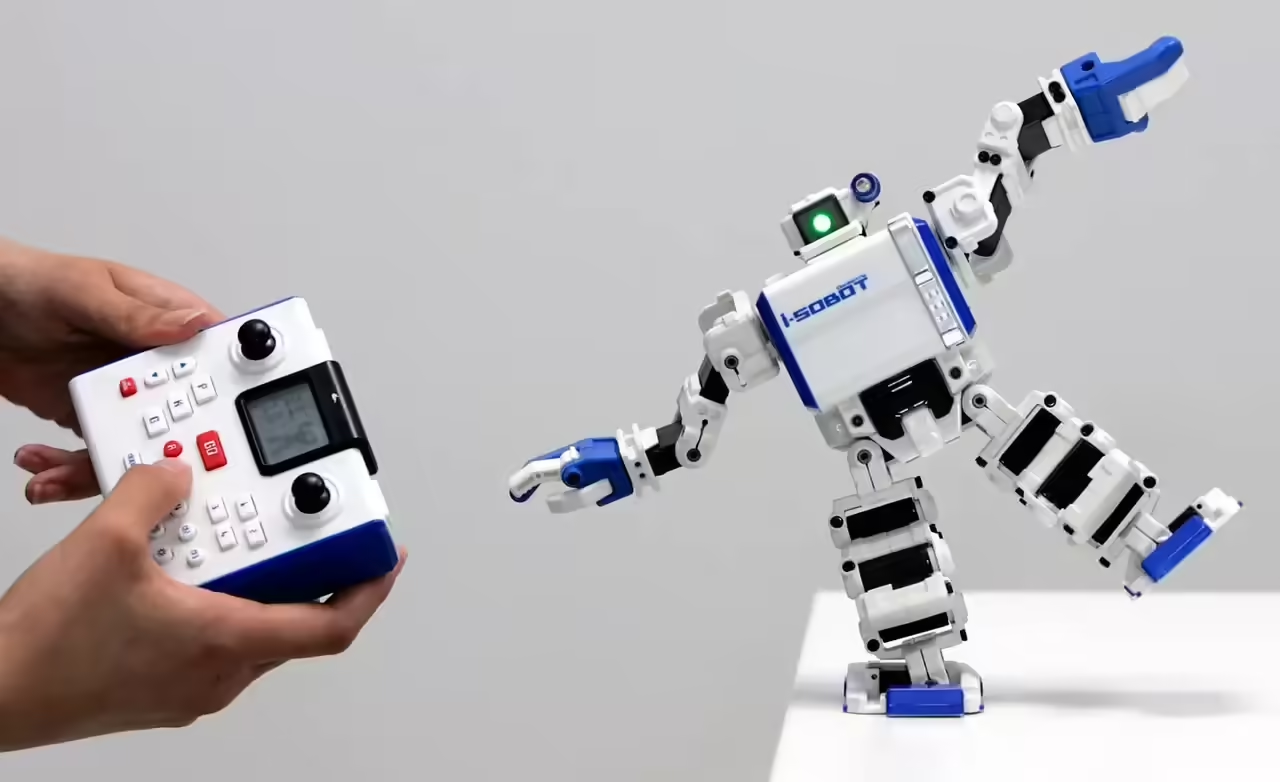
In the current era, marked by rapid technological advances, the miniaturization of robotics emerges as a fascinating and highly relevant field. In this context, miniature humanoid robots have captured the attention of researchers, enthusiasts, and the industry at large. These tiny automatons represent a significant milestone in the convergence of artificial intelligence and robotic engineering, offering a promising glimpse into the future of human-machine interaction.
The miniaturization of humanoid robots involves creating machines capable of imitating and replicating certain aspects of human behavior in a compact format. This research field has achieved notable milestones in terms of design, functionality, and versatility. From small household assistants to innovative medical tools, the application of these miniature robots spans various areas, playing a crucial role in improving the quality of life and efficiency across different sectors.
Importance of Miniaturization:
Miniaturization in robotics not only entails size reduction but also optimization of efficiency and performance. These advancements are possible due to improvements in artificial intelligence, biomechanics, and nanotechnology. The significance of this miniaturization lies in several key areas:
Accessibility and Versatility: Miniature humanoid robots are easily integrable into everyday environments due to their reduced size, making them versatile tools for a variety of tasks. From home assistance to the exploration of hazardous environments, their adaptability to different situations is a valuable aspect.
Collaboration in Restricted Environments: In spaces with limited room, such as medicine or manufacturing, miniature robots can play crucial roles by working closely with humans. This not only enhances efficiency but also reduces the risk of injuries in demanding work environments.
Advancements in Medicine: Miniaturization has led to the creation of robots capable of performing non-invasive medical interventions with unprecedented precision. From microsurgical operations to drug administration at the cellular level, these robots are revolutionizing healthcare.
Social Interaction: Miniature humanoid robots are also being used to enhance social interaction, especially for the elderly or those in need of companionship. Their anthropomorphic design facilitates emotional connection and communication.
Challenges and Future:
Despite notable advances, the miniaturization of humanoid robots presents technical and ethical challenges. Issues related to power sources, processing capabilities, and privacy concerns must be comprehensively addressed. Additionally, safe and ethical interaction between humans and robots raises questions about regulation and social acceptance.
Nevertheless, as research and development in this field continue, miniature humanoid robots are expected to play an increasingly significant role in our society. The convergence of miniaturization with artificial intelligence is paving the way for a future where harmonious collaboration between humans and robots redefines how we live and work.
History of Miniaturization in Robotics: The Evolution of Small-Sized Humanoid Robots
The history of miniaturization in robotics is a fascinating journey that has undergone remarkable transformation over the decades. Technological evolution has enabled the creation of humanoid robots in increasingly smaller sizes, opening new possibilities in various fields. Below is an overview of key stages in this development:
1960s – The Early Steps: In the early days of robotics, robots were bulky and rigid structures, far from any notion of miniaturization. However, the first steps towards creating smaller robots were taken. Initial applications included robotic arms used in industrial environments for specific tasks.
1980s – Advances in Electronics: With the progress of electronics, components became smaller and more efficient. Smaller and more advanced robots, though not humanoid, began to be used in various applications, from industry to medicine.
1990s – Mobile Robotics: Miniaturization took a significant turn with the development of mobile robots. Small autonomous vehicles began to explore unknown environments and perform specific tasks. While not humanoid, these robots demonstrated the viability of miniaturization in robotic mobility.
Early 21st Century – Integration of Sensors and Actuators: At the beginning of the 21st century, miniaturization focused on the integration of more advanced sensors and actuators. Advances in nanotechnology and precision manufacturing allowed the creation of smaller and more efficient components. The emergence of robots specialized in medical assistance, such as endoscopic capsules, marked a milestone in miniaturization applied to health.
Mid-21st Century – Miniature Humanoids: The convergence of artificial intelligence with miniaturization led to the creation of miniature humanoids. Researchers and companies began exploring the possibility of replicating specific aspects of human behavior in smaller robots. These miniature humanoids became interactive companions and personal assistants, integrating into everyday life.
Current Advances – Nanorobotics and Biomimicry: Currently, nanorobotics and biomimicry are taking miniaturization to unprecedented levels. Robots inspired by nature, such as insects or even cells, are being developed for specialized tasks. These tiny automatons have the potential to revolutionize medicine, space exploration, and other fields.
Size and Weight:
Compact Dimensions: Miniature humanoid robots stand out for their small size, usually in the range of 20 to 40 centimeters in height. This feature facilitates their mobility and integration into domestic and professional environments.
Lightweight: To ensure portability and efficiency in movement, these robots typically weigh between 1 and 3 kilograms, depending on their design and functionalities.
Materials Used:
Light Alloys: The robot’s structure is often constructed with lightweight alloys such as aluminum or titanium to maintain an optimal balance between strength and weight.
Flexible Covers: External parts of the robot may be coated with flexible materials like silicone, allowing smooth movements and providing additional protection in case of collisions.
Movement Systems:
Advanced Actuators: Miniature humanoid robots employ advanced electric actuators, such as compact and efficient servo motors, enabling precise and natural movements in the joints.
Propulsion Systems: Some models incorporate wheels, legs, or even magnetic propulsion technology to move efficiently on different types of surfaces.
Integrated Sensors:
Vision Sensors: Cameras and artificial vision sensors allow the robot to recognize and respond to its environment, facilitating navigation and interaction with objects and people.
Touch Sensors: Touch-sensitive surfaces or haptic sensors on the robot’s limbs enable it to detect and respond to physical contact, improving interaction in assistance and care scenarios.
Processing Capabilities:
Powerful Processing Units: Equipped with powerful processing units, these robots can perform complex tasks, learn from experience, and adapt to new situations.
Integrated Artificial Intelligence: The presence of artificial intelligence algorithms enables miniature humanoids to continuously learn, improve their performance, and adapt to user preferences.
Connectivity and Communication:
Wireless Technology: Integration of wireless technologies such as Wi-Fi and Bluetooth facilitates communication with other devices, as well as receiving remote software updates and improvements.
Intuitive User Interfaces: Some models include touch screens, voice recognition, or simplified user interfaces to facilitate interaction with users.
Autonomy and Power:
High-Capacity Batteries: To ensure significant autonomy, these robots are usually equipped with rechargeable lithium polymer batteries that offer several hours of operation.
Automatic Recharging Systems: Some models have the ability to automatically return to a charging station when energy is depleted.
Specific Applications:
Home Assistance: They can assist in household tasks such as cleaning, organizing, and reminders.
Health and Medicine: Used in assisted therapies, elderly care, and non-invasive medical assistance.
Education and Entertainment: Designed to interact and educate, some models serve as playful companions or learning assistants.
Innovations in Integrated Artificial Intelligence in Miniature Humanoid Robots: Expanding Horizons of Functionality and Versatility
The integration of artificial intelligence (AI) into miniature humanoid robots represents a significant advancement that transforms these tiny automatons into intelligent and versatile companions. Below, key innovations in AI incorporation are explored and how they contribute to the functionality and versatility of these robots:
Continuous Learning:
Machine Learning Algorithms: Miniature humanoid robots are equipped with machine learning algorithms that allow them to learn and adapt through experience. These algorithms, such as neural networks, enable continuous improvement in task performance and interaction with the environment.
Recognition and Response:
Advanced Visual Artificial Intelligence: Integrated artificial intelligence includes artificial vision systems that enable the robot to recognize objects, faces, and environments. This capability facilitates interaction, autonomous navigation, and task execution in response to visual stimuli.
Natural Language Understanding:
Natural Language Processing (NLP): The integration of NLP allows humanoid robots to understand and respond to verbal commands more naturally. They can interpret questions, perform requested actions, and engage in basic conversations, enhancing the user interaction experience.
Adaptability to User Preferences:
Preference and Customization Systems: Integrated AI can remember and adapt to user preferences over time. From music choices to home organization, these robots can adjust their actions based on specific user preferences and routines.
Contextual Decision-Making:
Contextual Analysis: AI enables humanoid robots to analyze the context in which they find themselves. They can make informed decisions based on the current situation, considering factors such as the time of day, location, and user needs.
Problem-Solving Skills:
Problem-Solving Algorithms: AI facilitates the robot’s ability to address unexpected situations or problems. They can apply problem-solving algorithms to overcome obstacles, adjust strategies, and efficiently complete tasks.
Emotional Interaction:
Emotion Recognition: Some models include emotion recognition capabilities, allowing the robot to respond empathetically to facial expressions and voice tones of the user. This contributes to a richer and more personalized interaction.
Safety and Ethics:
Safety and Ethics Algorithms: Artificial intelligence is also applied in managing safety and ethics. Robots can incorporate algorithms to avoid risky behaviors, protect privacy, and adhere to ethical principles in their interaction with users.
Future Perspectives and Anticipated Advances in Miniaturization of Humanoid Robots: Towards a Smarter and More Versatile Future
The miniaturization of humanoid robots is an ever-evolving field, and future perspectives suggest exciting advances that could further transform how we interact with technology. Possible directions and anticipated advances for the future are outlined below:
Improvements in Artificial Intelligence:
Continuous and Adaptive Learning: Integrated artificial intelligence in miniature humanoid robots is expected to evolve towards more advanced systems of continuous and adaptive learning. These robots could learn more quickly and efficiently, dynamically adjusting to new situations and improving their performance over time.
Environmental Awareness: The integration of more sophisticated data processing systems and advanced sensors will allow robots to have a more complete awareness of their environment. This will enable them to make more informed decisions and perform tasks more autonomously.
Enhanced Mobility and Agility:
More Efficient Locomotion: Advances in the miniaturization of actuators and propulsion systems could improve the mobility of humanoid robots on different terrains and conditions. These advances are expected to facilitate navigation in complex environments and increase the speed and agility of robots.
Flying Robots: Miniaturization could also extend to flying humanoid robots, allowing aerial exploration and performing tasks in environments inaccessible to ground-based robots. This could have applications in surveillance, search and rescue, among others.
Integration with Augmented Reality (AR) and Virtual Reality (VR):
More Immersive Experiences: The combination of miniature humanoid robots with augmented and virtual reality technologies could create more immersive and engaging experiences. This could have applications in education, entertainment, and remote collaboration.
Advanced Telepresence: Robots could act as robotic avatars, allowing people to interact with the world through remote presence. This integration could be valuable in professional, educational, or remote healthcare situations.
Advances in Brain-Computer Interface:
Mind Control: Research in brain-computer interface could enable miniature humanoid robots to be directly controlled by the user’s brain activity. This would open new possibilities for more intuitive interaction and task execution.
Sensory Feedback: Advanced haptic feedback could allow users to feel what the robots experience, creating a deeper connection and enhancing mutual understanding.
Miniaturization in Nanorobotics:
Microscopic-Scale Robots: Miniaturization could advance further, leading to the creation of nanoscale humanoid robots capable of performing tasks at the cellular level. This could have revolutionary applications in medicine, such as precise drug administration and microsurgical procedures.
Emphasis on Sustainability and Energy Efficiency:
More Efficient Energy Sources: Future advances could focus on implementing more efficient and sustainable energy sources, allowing miniature humanoid robots to operate for longer periods without the need for recharging.
Eco-Friendly Materials: The selection of materials for constructing these robots could lean towards more sustainable and environmentally friendly options.
In conclusion, the miniaturization of humanoid robots continues to be a dynamic and promising field, holding the potential to redefine our interactions with technology and contribute to a smarter and more versatile future.







